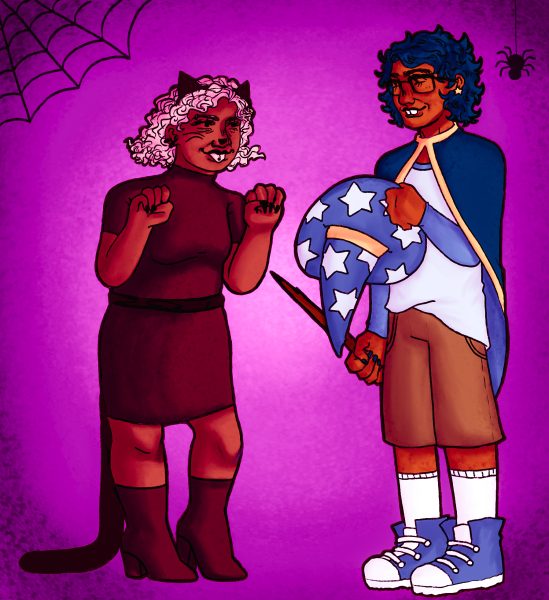
A beloved holiday in the United States, people eagerly anticipate the arrival of Halloween each year. Consumers flock to retailers to purchase candy in bulk and other seasonal merchandise. People scour Halloween specialty stores in search of their ideal costume. Meanwhile, families adorn their homes with spooky decorations.
Celebrating Halloween has become a cultural phenomenon. Yet, just like any other holiday, it is only one day. People often overlook how wasteful Halloween can be and the environmental ramifications.
For many, costumes are quintessential to the full Halloween experience, and costume planning creates most of the fun around the holiday. The National Retail Federation estimates that Americans spent $3.8 billion on costumes this year alone. What people don’t take into account while buying Halloween costumes, however, is their future use.
Freshman Marge Rosas mentioned how, on the occasions where he purchases Halloween costumes, he typically expects them to be worn once. “Sometimes I re-wear them, but it’s a Halloween costume, so it’s unlikely I’ll put it on again,” he said. “So usually not, but I could use it for another time that’s just not for Halloween.”
After Halloween, people often throw away their costumes because they no longer need or want them. As a result, costumes — commonly made of synthetic fabrics like polyester and nylon — comprise an overwhelming percentage of plastic in landfills once Halloween is over. Making sustainable choices with costumes can prevent unnecessary plastic waste.
“I tend to either use articles of clothing I already have to make Halloween costumes, and I go to thrift stores to look for items I need,” said senior Riley Hammond. “I go to local thrift stores outside of Boston because they tend to be cheaper.”
For those looking for more affordable prices, Hammond recommended going to Goodwill on Sunday. “Goodwill tags their clothing with colors,” she said. “There are sales for 50 percent off certain colors every day, and certain colors are $1.50 on Sunday.”
People more skilled with sewing and tailoring can try upcycling, a process where you repurpose materials to create something new out of them, extending their usage. Consider upcycling old Halloween costumes for new clothes or even to prepare as material for next year’s costume.
For costumes that you’ve outgrown or may not have any use for, research places to donate them where someone else can wear them. “I usually give them to churches for kids that can’t go trick-or-treating with their regular costumes,” Rosas said.
Aside from costumes, some of the most waste generated from Halloween festivities stem from candy. According to Forbes, Americans purchase approximately 600 million pounds of candy each Halloween season, with the average American consuming 3.4 pounds of candy. This overconsumption of candy, which often comes in plastic wrappers, is detrimental to the environment.
Since candy wrappers are small, they are difficult to recycle, usually ending up in landfills when thrown away. If not properly disposed of, wrappers can end up outside or in the ocean, leading to wildlife ingesting them. While people may enjoy the momentary taste of sugar, those pieces of candy do more harm than good.
Rather than overindulging in candy this Halloween, consider other alternatives. For Halloween-themed events or parties, buy baked goods in plastic-free or low-plastic containers, such as metal tins, or bake your own sweet treats. More filling than candy, different options can also be offered for those with dietary restrictions and allergies.
If baked treats aren’t an option, then opt for bulk bags of candy with minimal or recyclable packaging to reduce plastic waste. Smarties, Nerds and Whoppers are eco-friendly candies, coming in cardboard packaging.
One producer of waste that is not recognized much is pumpkins. In the United States, more than one billion pounds of pumpkins are grown, according to National Geographic. After being used as jack-o’-lanterns during the Halloween season, they are then tossed out and end up in a landfill, where they will release methane — a greenhouse gas more potent than carbon dioxide and a major contributor to climate change.
However, pumpkin pollution is easily avoidable if correctly disposed of. One way is by composting. Smash your carved pumpkin and add it into a compost bin with other food waste. If you don’t have a compost bin, simply mix the smashed pieces into dirt and cover the area with leaves, allowing decomposers like worms to do the rest.
Pumpkins are biodegradable, meaning that, when not haphazardly discarded, they do make for sustainable and plastic-free Halloween decorations. Those looking to purchase pumpkins should try obtaining them locally.
“Always buy your pumpkins from a local farm stand or market to support local agriculture,” advised Danah Hashem, an associate lecturer for the English Department.
Halloween arrives only one day every year, yet its environmental impact can be enduring. By applying sustainable practices, students can lessen the environmental burden and enjoy their Halloween as a green one.
This article appeared in print on Page 8 of Vol. LVIII Issue VI, published Nov. 4, 2024.

